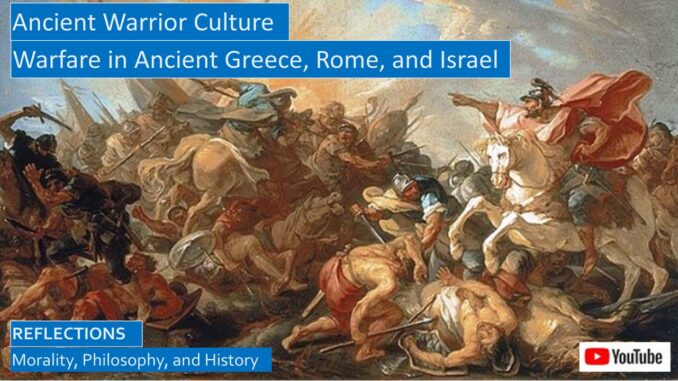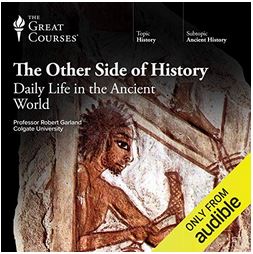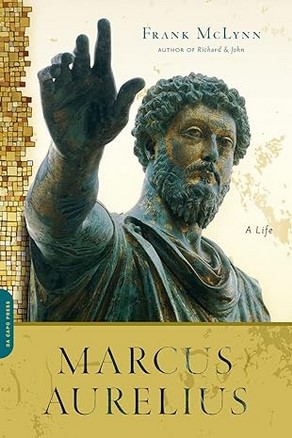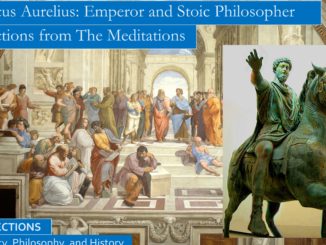
What can we learn by reflecting on the ancient warrior culture and warfare in ancient Greece, Rome, and Israel?
Why was the Greek army and navy superior to those of her neighbors? Why were the Spartan and Athenian hoplite infantry forces and the Athenian triremes, able to defeat the mighty Persian forces?
Did the Roman army become more proficient and professional under the Roman emperors? Why was the Roman army such an effective fighting force?
How does the Old Testament depict the warrior culture of ancient Israel and Judah? Did the armies of Joshua really massacre the wicked pagans in the Promised Land?
Blog and video for Ancient Warrior Societies, Blog 1, The Warrior Ethos of Ancient Greece, Rome, and Israel
https://seekingvirtueandwisdom.com/ancient-warrior-societies-blog-1-the-warrior-ethos-of-ancient-greece/
https://youtu.be/7QAZ_s6zw4E
Ancient Warrior Societies, Blog 3, World of the Old Testament
https://seekingvirtueandwisdom.com/ancient-warrior-societies-blog-3-world-of-the-old-testament/
Powerpoint Script with Book Links:
https://www.slideshare.net/BruceStrom1/ancient-warrior-culture-concubines-and-slaves-ancient-greece-rome-and-israel
YouTube video for this blog and blog 3:
https://youtu.be/9xKxqAbJ2qY
EMPIRES MADE LIFE SAFER AND MORE SECURE FOR ORDINARY PEOPLE
The brutality of living in a warrior culture was subdued when an empire conquered surrounding city-states and held them. Those who were not enslaved but were left behind often led a quasi-independent existence, paying tribute to the far-off king. After several generations they lost their martial spirit, as they no longer feared that they would be conquered and enslaved, as they were under the protection of the empire. This happened when the Greek colonies on the western coast of Ionia, or Turkey today, were conquered by the Persians. The Greek historian Thucydides tells us that the mainland Greeks were not able to train the trireme crews of the Ionian Greeks as they lacked military discipline and martial spirit.
Blog Category and YouTube Playlist for Peloponnesian Wars:
https://seekingvirtueandwisdom.com/category/peloponnesian-wars/
https://www.youtube.com/playlist?list=PLJVlY2bjK8lg2pivnGN3m13VI8YstKs0T
Likewise, after the Macedonians conquered the Greek mainland, the Greeks were not able to overcome the invading Romans several generations later. Likewise, after the Romans conquered Judah and Israel, by the time of Jesus many Jews had lost the military spirit of the Maccabeans. This could explain why Jesus in the New Testament exhorts us to love our enemies and turn the other cheek, while the Old Testament, written when the Jews were in a warrior culture, only exhorted the Jews to love their fellow Jews. Why love other nations who might slaughter your men and enslave your women and children? Indeed, in his book on Hillel, Rabbi Telushkin comments that Jews are not fond of turning the other cheek because they believe in justice for the oppressed.
Hillel and Jesus, Reflections on Rabbi Telushkin’s Observations
http://www.seekingvirtueandwisdom.com/hillel-and-jesus-reflections/
Comparing Hillel and Shammai to Jesus
http://www.seekingvirtueandwisdom.com/comparing-hillel-and-shammai-to-jesus/
More Stories and Sayings of Hillel and Shammai
http://www.seekingvirtueandwisdom.com/more-stories-and-sayings-of-hillel-and-shammai/
Comparing the Teachings of Jesus, Hillel, and Shammai
https://youtu.be/ygxn2qqGnOI
In our first video we discussed how most ancient cultures, and in particular the cultures of ancient Greece, Rome, and Israel, are warrior cultures out of necessity, as warfare was a fact of life. We reflected on what Homer’s Iliad and Odyssey reveals about this warrior culture, and how this underpinned ancient attitudes towards concubines and slaves. In the ancient world, slaves were either born into slavery or were captured during wars or by pirates.
Ancient Warrior Culture, Blog 1, War, Slaves, and Concubines in Ancient Greece, Rome, and Israel
https://seekingvirtueandwisdom.com/ancient-warrior-societies-blog-1-the-warrior-ethos-of-ancient-greece/
https://youtu.be/7QAZ_s6zw4E
Slaves were the employees of the ancient world, and sexual abuse of women was a problem under all systems of slavery, and is still a problem today, especially when women hold low-paying or entry-level positions.
Slaves in the Ancient World, Blog 1, Were Slaves the Employees of the Ancient World?
http://www.seekingvirtueandwisdom.com/slaves-in-the-ancient-world-blog-1-were-slaves-the-employees-of-the-ancient-world/
Slaves in Ancient Greece and Rome, Blog 2
http://www.seekingvirtueandwisdom.com/slaves-in-ancient-greece-and-rome-blog-2/
https://youtu.be/O67cmVRvBtA
GREEK INNOVATIONS IN WARFARE
The Greek innovation to ancient warfare was their hoplite warrior phalanx, a formation of eight to ten rows of a hundred or more warriors, sometimes extending a quarter of a mile. The shields of the front row would interlock, and the entire formation would press upon the enemy, the soldiers would first throw their spears then jab with their swords from behind their shields, strictly maintaining their position. This required training and practice, the Athenians expected their nobles to drill during the year, while the Spartans had a year-round military that practiced year-round, living in barracks.
These Greek hoplite phalanxes were terrifying to encounter on the battlefield. In the first Persian War, at the Battle of Marathon, the Athenian phalanxes approached the Persian forces at a run, shouting war hoops, the Persian mercenaries were not quite used to this élan, they panicked and were slaughtered as they ran. In the second Persian War the three hundred Spartan hoplites held off the entire Persian army in the famous battle at the Pass of Thermopylae.
Before the Battle for the Pass of Thermopylae, the Spartans were seen brushing their long braids. The Persian king asked his Greek military advisor why they would do this, and he responded that is always what Spartans do before they know they will face death in battle. Spartan women would admonish their sons to either return as heroes or dead on their shields. Herodotus relates that when a Spartan was told that the Persian army was so numerous that when they fired their arrows, they would blot out the sun. The Spartans responded that this was good, it meant they could fight in the shade.
Histories of Herodotus, The Greeks Defeat the Mighty Persians in the Greco-Persian Wars
http://www.seekingvirtueandwisdom.com/histories-of-herodotus-the-greco-persian-wars/
https://youtu.be/JjNcyLo54ko
Often hoplite armies parried in a stand-off with no winners. Usually battles were only an hour, some sources estimate that typically there was five percent casualty rate for winners and three times these casualties for the losing side, though other sources suggest that in particularly brutal battles the losing side could suffer horrendous casualties if they broke and ran and were slaughtered by the opposing army.
The well-off noble citizens of ancient Greece were expected to purchase their hoplite equipment. This included a round leather shield covered in bronze, a bronze helmet and breastplate, greaves or shin armor, an eight-foot long thrusting spear, and a short sword.
Most Greek cities had only the infantry hoplites, they had no cavalry forces because horses were not that effective when fighting in mountainous Greece. Later King Phillip and his son Alexander the Great of Macedon would improve upon the Greek military formations by equipping his hoplite soldiers with fifteen-foot-long spears and adding cavalry units of archers and swordsmen, or other units that took advantage of military skills of his non-Greek subjects.[1]
Were the Spartans the best hoplite infantry soldiers in the Greek world? Although the Spartans were fulltime soldiers, Athens could field a hoplite army equal in both skill and bravery to any Spartan hoplite army, and it was the Athenian hoplites who defeated the Persian army in the Battle of Marathon. Before the Peloponnesian Wars, the Athenian hoplites had bested Spartan hoplites in battle.
Unique Spartan Warrior Culture and History, Plutarch’s Life of Lycurgus, Lawgiver of Sparta
https://seekingvirtueandwisdom.com/unique-spartan-warrior-culture-and-history-plutarchs-life-of-lycurgus-lawgiver-of-sparta/
Sparta, Quotes from Plutarch, Herodotus, Thucydides, and Xenophon
https://youtu.be/_hYwZsxmC3s
The Athenian Empire was an ancient Mediterranean version of the British Empire. Athens was a naval power with an extensive trading network from Egypt to the shores of the Black Sea, and they had a large fleet of several hundred triremes that defeated the Persian navy. These triremes had three files of rowers, about 170 in total, carrying a small contingent of archers and hoplites. Triremes were fast ships that had a bronze battering ram below the waterline at the front of the ship that was used to sink the opposing ship. Triremes were like huge rowboats, they had to beach overnight and at mealtime, rarely did they attempt to cross the Mediterranean.
The rowers were citizens who usually were not property owners, they were a full-time professional navy paid by the state. It took a great deal of skill and stamina to row these triremes, the crews drilled year-round. These sailors were participants in the democracy of Athens, then as now veterans demanded that their voices be heard by the government.[2] We also reflect on Greek warfare by land and sea in our blogs of the Histories of Herodotus, and our blogs and videos on the Peloponnesian Wars.
Histories of Herodotus, The Greeks Defeat the Mighty Persians in the Greco-Persian Wars
http://www.seekingvirtueandwisdom.com/histories-of-herodotus-the-greco-persian-wars/
https://youtu.be/JjNcyLo54ko
ROMAN INNOVATIONS IN WARFARE
Like Alexander the Great, the Romans fielded professional armies that could fight for years at a time in distant theaters of war. Alexander’s Greek army and the later Roman armies intermarried with the locals and recruited foreign soldiers. Under the Roman Emperor Octavian, the army started to recruit volunteers into the army as professional soldiers who would enlist for many years. By the end of first century, volunteers outnumbered conscripts in the Roman army, probably one in five of Roman citizens were conscripts in the army. Non-citizens could enlist as auxiliaries that were promised citizenship at the end of their service, adding cultural diversity to the army. When soldiers were injured or had served for twenty-five years they retired on farms in the provinces, sometimes receiving a stipend, which helped to integrate the empire.
The historian Garland tells us, “the conditions of service in the Roman army were sometimes appalling. According to Tacitus, some men served for 30 to 40 years, ‘their bodies maimed by wounds.’ When they were finally discharged, they might be given ‘a waterlogged marsh or unplowed hillside’ to farm.”
One of the fatal weaknesses of the old Roman Republic is the army rather than the state recruited the soldiers. Starting with Julius Caesar and the early Roman Emperors, the Roman armies were more loyal to their generals than to Rome, which meant that the empire would often be embroiled in civil wars when competing generals fought to be Emperor. The system was reformed during the reign of Emperor Diocletian, who established a bureaucracy to administer both the military and empire, dividing the empire into a more easily administered Western and Eastern divisions.
The training of Roman armies is similar to modern armies, new soldiers had to go through a four-month boot camp located near the Tiber River. They were taught how to use a sword, spear, bow and arrow, darts and slings, and how to swim, build a camp, and practice formations. They fought in formation somewhat like the hoplites, but more mobile, more like the army of Alexander. The Roman army was organized into legions, they would charge when they were about thirty yards from their enemy, hurling their spears.
Like the Greeks, they had a shield, helmet and breastplate, spear, dagger and sword, all weighing over sixty pounds. In addition, they marched with the tools needed to build a camp, pickaxe, saw, space, and a basket for moving earth. When they weren’t fighting, they built and maintained the road system of the Roman empire and other infrastructure like bridges.[3]
Under the Roman emperors, like the United States armed forces, the army became more proficient and professional. The biographer of Marcus Aurelius stated that no other nation in the ancient world “matched the Roman army in discipline, technique and efficiency. The Roman army was superbly trained, and its arms and equipment were superior to those of its enemies. Her commanders had perfected the use of cavalry as shock troops, and the skill of her engineers was legendary: whether the task was to build a bridge over the Danube or break down the impregnable fortresses like Masada, they could always find a way.”
In Marcus Aurelius’ time, “only men of senatorial rank could command a legion; members of the equestrian order were restricted to commanding the brigades of auxiliaries.” Legions posted in the provinces worked closely with the governors. Although disaster could strike when a less competent commander misdirected the forces under his command, when left alone the Roman legions could rarely be beaten. For example, when the co-emperor with Marcus Aurelius, Lucius Veras, was titular head of the legions battling the Persians in Parthia, he spent his time hunting and carousing, leaving his capable commanders to run the successful war.[4]
As time passed, the provinces became more romanized, and more of the so-called barbarian warriors were inducted into the Roman army. After the Parthians were subdued under Marcus Aurelius, the German tribes surreptitiously formed a coalition to challenge Roman power in Germania and the Alps, there were fears the Germanic tribes would invade Italy as the Carthaginian general Hannibal and his elephants had done centuries before. The German forces were more effective because they adopted some Roman military practices, though they were still no match for the long-term strategy and military discipline seen under the leadership of Emperor Marcus Aurelius. Also, their barbarian warrior ethos dictated that they would attack in mass against the strongest point of the Roman line, which, though more courageous, was often a problematic tactic. The Romans fought a war of attrition, patiently dividing and conquering the Germanic tribes one by one, and though they slaughtered the men from some tribes, other tribal warriors were hired as mercenaries to fight in other theaters of war and were effective fighting forces.[5]
In our next blog we reflect on the warrior culture of Judah and Israel as depicted in the Old Testament.
Ancient Warrior Societies, Blog 3, World of the Old Testament
https://seekingvirtueandwisdom.com/ancient-warrior-societies-blog-3-world-of-the-old-testament/
[1] https://sites.psu.edu/thehopliteexperience/the-phalanx/
[2] Robert Garland, The Other Side of History: Daily Life in the Ancient World, lectures recorded by The Great Courses, (www.thegreatcourses.com, 2012), Lecture 13, Being a Greek Soldier or Sailor
[3] Robert Garland, The Other Side of History, Lecture 25, Being a Roman Soldier
[4] Frank McLynn, Marcus Aurelius (Cambridge, MA: Da Capo Press, 2009), pp. 149-150.
[5] Frank McLynn, Marcus Aurelius, pp. 333-368.






11 Trackbacks / Pingbacks